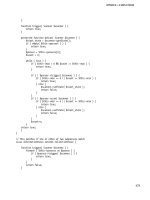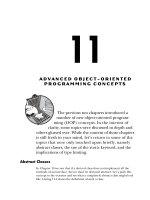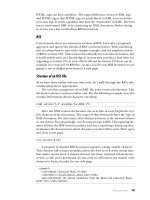OBJECT-ORIENTED PHP Concepts, Techniques, and Code- P11 potx
Bạn đang xem bản rút gọn của tài liệu. Xem và tải ngay bản đầy đủ của tài liệu tại đây (301.24 KB, 10 trang )
Improvement Through Inheritance 81
Overridden Methods
Listing 10-3 shows all the code required to create a class derived from
Exception. There are only two methods and both are overridden parent
class methods.
But let’s take a more detailed look, beginning with the constructor. Note
how it checks the value of the error number. This test is designed to separate
errors attributable to the programmer from all other errors.
We’ve chosen the range 5,000 and greater because this range is not used
by built-in MySQL errors. The message associated with programmer errors
indicates misuse of the class, and differentiating client programmer errors
from other errors makes it easier to use the database classes.
For clarity, the error message includes the class name, which we avoid
hard-coding by using the constant
__CLASS__. After identifying the type of
error, the
Exception class constructor is called using the scope resolution
operator and the keyword
parent. (You encountered similar syntax when you
referenced a static variable in Chapter 9.) This is the syntax for calling any
parent method from within a derived class, and one of the few cases where
it’s necessary to invoke a magic method directly.
As you can see, there is no need to hard-code the parent class name
because all constructors are invoked by calling
__construct—the very reason
for introducing a magic construction method in PHP 5.
NOTE If a derived class overrides a parent constructor, there is no implicit call to the parent.
The call must be made explicitly, as in Listing 10-3.
The
__toString method defined in Listing 10-3 replaces the __toString
method inherited from the parent class. As a result, a
MySQLException echoed
to the screen shows only the error number and the associated message, which
is much less informative than the
__toString method of the parent class
(which traces the error and shows its line number). This makes for more
secure production code because it reduces the information associated with
an exception, but it also makes development of applications more difficult.
(You may want to comment out this code while debugging an application.
By so doing, you revert to the more informative method of the parent.)
Changes to the MySQLConnect Class
The changes required so that the MySQLConnect class can use MySQLException
objects are minimal. Of course the
MySQLConnect class needs to know about
this derived exception class, but this is easily accomplished with the following
statement:
require 'MySQLException.php';
OOPHP_02.book Page 81 Friday, May 5, 2006 2:25 PM
82 Chapter 10
Next, you need an error code number that is greater than or equal to
5,000 (that is, outside the range used by MySQL). Then define a constant
class value using the keyword
const and give this constant a name using
uppercase letters (per convention). The
const keyword performs the same
task for OOP as the
define function does for procedural programming—it
declares a variable that cannot be changed. Constant data members do not
use access modifiers, so they are effectively public.
const ONLY_ONE_INSTANCE_ALLOWED = 5000;
The only other changes involve the constructor, as shown in Listing 10-4.
public function __construct($hostname, $username, $password){
if(MySQLConnect::$instances == 0){
if(!$this->connection = mysql_connect($hostname, $username,$password )){
throw new MySQLException(mysql_error(), mysql_errno());
}
MySQLConnect::$instances = 1;
}else{
$msg = "Close the existing instance of the ".
"MySQLConnect class.";
throw new MySQLException(
$msg, self::ONLY_ONE_INSTANCE_ALLOWED);
}
}
Listing 10-4: Changes to the
MySQLConnect constructor
Compare Listing 10-4 with Listing 10-2. Notice that the calls to the die func-
tion have been removed, and an exception has been constructed in their place.
The new keyword
throw ( ) is used exclusively with exceptions. It hands off the
exception to be dealt with elsewhere (as you’ll see in the following section).
The first
MySQLException is constructed using the built-in MySQL error
number and message. In the second case
an appropriate message is created
and the class constant,
ONLY_ONE_INSTANCE_ALLOWED, is passed to the constructor.
(Notice the syntax for referencing a class constant using the scope resolution
operator and the keyword
self; this is exactly the same way that a static vari-
able is referenced.)
Prodding Your Class into Action
If you force an exception by attempting to create a second connection without
closing the first one, you see this message:
Error: 5000 – MySQLException type. Improper class usage. Close the existing
instance of the MySQLConnect class.
This tells you the class the exception belongs to, that the error results
from misuse of the class, and how to rectify the error.
Changes to the
MySQLResultSet class are identical to the changes shown
above. Constant data members with values greater than 5,000 are added to the
OOPHP_02.book Page 82 Friday, May 5, 2006 2:25 PM
Improvement Through Inheritance 83
class in order to identify class usage errors, but otherwise existing error num-
bers and messages are used. (We won’t deal with the details here; to view those
changes, download the files associated with this chapter.)
NOTE Were you to develop the MySQL classes further, you might end up with an unwieldy number
of constants. In that case it would make sense to remove constant data members from
their respective classes and store them in a file associated with the
MySQLException class,
or perhaps define them all in the
MySQLConnect class, thereby avoiding possible numbering
conflicts.
Catching Exceptions
You have now finished all the changes in your database classes that relate to
exceptions. All you need to do now is to see how exceptions are caught by
enclosing your code within a
try block.
A try block is a programming structure that is used to enclose code that
may cause errors. It is always followed by a
catch block. An error, or more
properly speaking an exception, that occurs within the
try is thrown and
handled by the
catch. This is why a try/catch block is said to handle exceptions.
However, there are important differences between error trapping and
exception handling. The argument to a
catch clause is always an object. Any
Exception that occurs within the scope of the try block will look for a catch
that has a matching
Exception type as its argument.
NOTE The identification of the object type in a catch block is called type hinting. We’ll discuss
this in greater detail in Chapter 11.
You should begin the
try block immediately before the first line of code
that might throw an exception (namely, where we create a connection object).
Then enclose every subsequent line of code within the
try block, except
for the
catch blocks. The code is otherwise identical to that in the page.php
file, included with the file downloads for Chapter 9; only the relevant parts
are reproduced in Listing 10-5.
try{
$con = new MySQLConnect($hostname, $username, $password);
//all remaining code
}
catch(MySQLException $e){
echo $e;
exit();
}
catch(Exception $e){
echo $e;
exit();
}
Listing 10-5: The
try block and catch blocks, showing how exceptions are caught
OOPHP_02.book Page 83 Friday, May 5, 2006 2:25 PM
84 Chapter 10
You follow the try block with two catch blocks: one to catch the
MySQLException class and the other to catch the parent class, Exception. Any
code that throws an exception will be caught by one of the
catch blocks.
A thrown exception looks for the first matching exception type in the
following
catch blocks. When it finds a match, it executes the code within that
block. It ignores all other
catch blocks (unless it is re-thrown). For example, if
a
MySQLException is thrown in the try block of Listing 10-5, it will be caught by
the first
catch, and the code in the second catch won’t execute.
The order of the
catch blocks is the inverse order of inheritance: The
child class must precede its parent. Should the
catch block for a parent class
precede the child class, the exception will always be caught by the parent,
and the child
catch will be unreachable.
When using typical procedural error handling, you must check for errors
immediately following the code that may cause problems. As you can see in
Listing 10-5, an
Exception may be caught many lines away from where the
problem occurs, which is an advantage because it makes for more readable
and maintainable code.
Implementing an Interface
Inheriting from an existing class is a very powerful tool in the OO program-
mer’s arsenal. However, it’s not always the appropriate one to use, because
PHP doesn’t allow a class to have more than one parent class.
This generally seems to be a good thing; it avoids the complexity that can
be introduced with multiple inheritance. However, suppose that you had cre-
ated a more abstract database result set class and derived your
MySQLResultSet
from it. With single inheritance it would be impossible for your class to also
inherit from any other class.
For this reason PHP allows multiple inheritance, but only for interfaces.
As you saw in Chapter 2, an interface is a class with no data members that
declares but does not define methods (something that is left to the derived
class). An interface acts like a skeleton, and the implementing class provides
the body. Although a class can have only one parent class, it can implement
any number of interfaces.
DEALING WITH EXCEPTIONS
Your catch blocks in Listing 10-5 simply output the error number and message and
end the application; there’s no need to recover from these exceptions or take any
other action. But this isn’t always the case. For example, suppose you create an
application that allows users to create their own SQL statements to query a data-
base. When errors in syntax occur it would make sense to display the error message
and reload the web page rather than simply exit the application. There are some
notable differences between error handling in PHP and other languages. For instance,
PHP doesn’t require that exceptions to be caught and does not support a
finally
block.
OOPHP_02.book Page 84 Friday, May 5, 2006 2:25 PM
Improvement Through Inheritance 85
Listing 10-6 shows the code for the interface we wish to use to improve
the
MySQLResultSet class: the Iterator.
interface Iterator{
public function current();
public function key();
public function next();
public function rewind();
public function valid();
}
Listing 10-6: Methods of the
Iterator interface
Note that instead of beginning with the keyword class, Iterator begins
with
interface, but otherwise it looks like a class. Notice too that method
names have access modifiers and that the method declarations are followed
by semicolons. There are no braces following the method names because
there is no implementation—which is precisely what makes an interface an
interface. The interface is a skeleton; an implementing class must flesh it out.
Learning About the Iterator Interface
Here’s a brief description of each method in the Iterator interface:
A bit more can be gleaned from watching an iterator in action. For exam-
ple, the code shown in Listing 10-7 traverses an iterable object using all of the
methods in the
Iterator interface.
$iterator->rewind();
while($iterator->valid()){
echo $iterator->key();
print_r($iterator->current());
$iterator->next();
}
Listing 10-7: Using the methods in the
Iterator interface to traverse an iterable object
You begin by calling the rewind method to ensure that you are at the start
of the result set. The call to
valid controls the while loop so that it continues
only as long as there is another record to retrieve. In our implementation,
the key returned by the
key method will be a number; it is displayed here
simply for demonstration purposes. The method
current returns the record
that the result set currently points to. Finally, a call to
next advances the record
pointer.
current
Returns the current element
key
Returns the key of the current element
next
Moves forward to the next element
rewind
Rewinds the iterator to the first element
valid
Checks to see if there is a current element after calls to rewind
or
next
OOPHP_02.book Page 85 Friday, May 5, 2006 2:25 PM
86 Chapter 10
You’ve probably used foreach loops in many different circumstances
(most likely with arrays), but you may not have given much thought to what
goes on in the background. Listing 10-7 shows what happens in a
foreach
loop. At the start of the loop an implicit call is made to the
rewind method,
ensuring that you are at the beginning and that the first record is ready to be
displayed. If there is a valid record you can enter the loop with the record
pointer pointing to the current row. The record pointer is then advanced—
by making an implicit call to
next—and the process is repeated until the end
of the record set is reached.
Implementation
To implement an interface, you need to indicate inheritance in your class def-
inition. When inheriting from a class you use the keyword
extends, but when
inheriting from an interface you use
implements. Your class definition now reads
class MySQLResultSet implements Iterator
Implementing an interface also requires that all methods be defined.
In this particular case you must add the five methods of an iterator, as well
as the new data members
currentrow, valid, and key, to your existing class. The
currentrow member will hold the value(s) of the current row. The member valid
is a Boolean that indicates whether there is a current row. The member
key
simply functions as an array subscript.
Five New Methods
The first three methods that your new class MySQLResultSet inherits from the
Iterator interface are straightforward accessor methods that return the value
of the newly added data members, like so:
public function current (){
return $this->currentrow;
}
public function key (){
return $this->key;
}
ITERATOR METHODS
We’ll seldom use the iterator methods directly. We’re implementing this interface so
that we can use a
MySQLResultSet within a foreach loop. In a sense, these methods
are magic because they are invoked in the background by the
foreach construct in
much the same way that the
__toString method of the MySQLException class is invoked
when a
MySQLException object is displayed. Any object used within a foreach loop
must devise its own implementation of the iterator methods. The implementation will
differ depending upon the nature of the object—an iterator that traverses file directories
will differ significantly from a result set iterator, for example, but all objects that
implement a specific interface will exhibit common behaviors. The point of an
interface is that it guarantees the existence of specific methods without specifying
what exactly these methods should do.
OOPHP_02.book Page 86 Friday, May 5, 2006 2:25 PM
Improvement Through Inheritance 87
public function valid (){
return $this->valid;
}
The method current returns the value of the current record if there is
one;
key returns its array subscript; and valid returns true unless the record
pointer is positioned at the end of the record set. The more interesting meth-
ods, however, are
next and rewind. First, let’s look at the next method:
public function next (){
if($this->currentrow =
mysql_fetch_array($this->result)){
$this->valid = true;
$this->key++;
}else{
$this->valid = false;
}
}
In this code, you see that next attempts to retrieve the next row from the
result set, and then resets the data members
valid and key accordingly.
As you would expect,
rewind resets the record pointer to the beginning of
the result set after first checking that the number of rows is greater than 0.
This method must also maintain the
valid and key data members. The data
member
valid indicates whether there is a current row, and key is reset to 0.
Here’s the
rewind method:
public function rewind (){
if(mysql_num_rows($this->result) > 0){
if(
mysql_data_seek($this->result, 0)){
$this->valid = true;
$this->key = 0;
$this->currentrow = mysql_fetch_array($this->result);
}
}else{
$this->valid = false;
}
}
This method works because your result set is buffered; it was created using
the function
mysql_query. Because a buffered result set stores all rows in mem-
ory,
the record pointer can be repositioned.
NOTE An unbuffered result set uses a forward-only cursor, so it cannot use the mysql_data_seek
function. Unbuffered result sets are discussed in both Chapter 15 and Chapter 16.
What to Do with Flightless Birds
Flightless birds such as the emu and the ostrich are unquestionably birds,
but they lack one defining characteristic of birds—flight. Like flightless birds,
unbuffered result sets lack one characteristic of an iterator. Unbuffered result
sets are unquestionably iterable, but they cannot be rewound.
OOPHP_02.book Page 87 Friday, May 5, 2006 2:25 PM
88 Chapter 10
When I introduced interfaces I defined them as classes that have meth-
ods but no body for those methods. A class that implements an interface
must provide the body for every method of the interface. What, then, do you
do with an unbuffered result set and the
rewind method?
Just as flightless birds simply don’t fly, an unbuffered result set can define
a
rewind method that does nothing.
NOTE The problem of unwanted methods of an interface is not peculiar to PHP. Other OO
languages such as Java circumvent this problem by using “adapter” classes that provide
an empty implementation of unwanted methods and only require that desired methods
be defined.
Leaving a Method Undefined
If you implement an interface but don’t define all of its methods, you’ll receive
a fatal error message. For example, if you try to use the
MySQLResultSet class
without defining the
key method, you’ll see a fatal error like this:
Class MySQLResultSet contains 1 abstract methods and must therefore be
declared abstract (Iterator::key)
Not the error you would expect, perhaps, but an error nonetheless, and
an informative one at that. As you can see, even though you haven’t imple-
mented the
key method, it hasn’t gone away because it is inherited from the
Iterator interface. (The key method is considered abstract because it has no
implementation.)
There are two ways to eliminate this error message. The obvious one, of
course, is to define the
key method. However, you could also create error-free
code by adding the modifier
abstract to your class by changing the declara-
tion
class MySQLResultSet to abstract class MySQLResultSet.
You’ve just created your first abstract class, which is a class with one or
more methods that lack an implementation. A purely abstract class is one in
which all methods lack an implementation, as with all methods in an inter-
face. The only difference between a purely abstract class and an interface is
that it is defined as a class rather than as an interface.
NOTE You cannot create an instance of an abstract class; you must inherit from it and
implement the abstract method(s), as with an interface. You’ll learn about abstract
classes in the next chapter.
Implementation and Access
By removing the key method and forcing an error we learned a few more
things about OOP. Let’s see what we can learn by changing the access modifier
of the
rewind method from public to private. Do this and preview the class in
your browser. You should see this fatal error:
Access level to MySQLResultSet::rewind() must be public (as in class Iterator)
OOPHP_02.book Page 88 Friday, May 5, 2006 2:25 PM
Improvement Through Inheritance 89
Not only must you implement all the methods of the Iterator interface,
you cannot make access to those methods more restrictive. If you think about it
this makes good sense. The
foreach construct needs a public rewind method—
it would not have access to a private
rewind method.
However, you can make access less restrictive because doing so will not
interfere with the way other classes expect your implementation to behave.
For example, you could make
protected methods public. (This rule applies in
all cases of inheritance, not just to interfaces.)
Iterating Through a MySQLResultSet
In Chapter 9 you traversed your result set using a while loop and the getRow
method like so:
while($row = $rs->getRow()){
echo $row[0]." - ".$row[1];
echo "<br />\n";
}
Because you’ve implemented the Iterator interface you can traverse your
result set using a
foreach loop. The while loop above is now replaced by this:
foreach($rs as $row ){
echo $row[0]." - ".$row[1];
echo "<br />\n";
}
As you can see, it is more difficult to implement the Iterator interface than
it is to create a method suitable for use in a
while loop. Although this may seem
like a lot of pain for no gain, there are advantages to this approach. For exam-
ple, we can iterate through a record set a number of times, by simply starting
another
foreach loop. The record pointer will be reset in the background with-
out any action on your part. Had you used your original code, you would have
had to write a
rewind method and explicitly call it before repeating a while loop.
NOTE Learning about the Iterator interface is time well spent as a number of built-in classes
and interfaces inherit from this interface. For example, there is a
DirectoryIterator class—
a versatile replacement for the
DirectoryItems class you developed in the early chapters.
Where to Go from Here
In this chapter we’ve improved on our original database classes by creating
our own exception class. This, in turn, allowed us to take a completely OO
approach to handling exceptions rather than simply trapping errors and
terminating the application. We added the ability to use a
MySQLResultSet in
a
foreach loop by implementing the Iterator interface, and we explored the
concept of inheritance both for classes and for interfaces.
We’ve spent a lot of time creating database classes because they are
useful tools for making websites dynamic. In the next chapter, we’re going
to take a detailed look at some of the concepts introduced here. After that
we’ll take a look at other ways to add content to a website dynamically.
OOPHP_02.book Page 89 Friday, May 5, 2006 2:25 PM
OOPHP_02.book Page 90 Friday, May 5, 2006 2:25 PM









